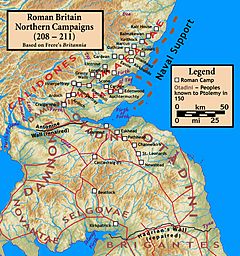Roman invasion of Caledonia (208–211) facts for kids
Quick facts for kids Severan invasion of Caledonia |
|||||||
|---|---|---|---|---|---|---|---|
| Part of Roman conquest of Britain | |||||||
 |
|||||||
|
|||||||
| Belligerents | |||||||
| Roman Empire | Caledonians | ||||||
| Commanders and leaders | |||||||
| Septimius Severus Caracalla |
Unknown | ||||||
| Casualties and losses | |||||||
| 50,000 dead (mostly from disease and exhaustion) | unknown | ||||||
The Roman invasion of Caledonia was a big military campaign. It was started in 208 CE by the Roman emperor Septimius Severus. This invasion aimed to conquer Caledonia, which is now modern-day Scotland.
The war continued until late 210 CE. Emperor Severus became very sick and passed away in Eboracum (York) on February 4, 211 CE. At first, the Roman army did well, quickly reaching the Antonine Wall. However, when Severus moved further north into the highlands, his army faced tough guerrilla tactics. The Romans could never fully take control of Caledonia.
Severus did manage to take back many forts that Agricola had built over 100 years earlier. This happened after a battle called Battle of Mons Graupius. By doing this, he made it harder for the Caledonians to attack Roman Britain. After Severus died, his son Caracalla stopped the invasion. The Roman soldiers then went back to Hadrian's Wall.
Contents
Why Did Rome Invade Caledonia?
The main reason Emperor Severus invaded Caledonia (which is now Scotland) was because of many attacks. These attacks were happening more often against Roman Britain. This was possible because of an event in 195 CE. At that time, Clodius Albinus, the Roman Governor of Britain, took most of the Roman armies from Britain to Gaul. He did this because he was rebelling against Severus.
Severus sent these armies back to Britain after he defeated Albinus. But the armies had lost many soldiers in a battle called Battle of Lugdunum. This meant that Hadrian's Wall did not have enough soldiers to guard it. This made it easy for the Caledonians to raid into Roman Britain. The Caledonians were also working together more, which helped them gather larger groups for their raids.
The Roman Invasion Begins
In 208 CE, Emperor Severus arrived in Britain. He brought a very large army, with about 40,000 soldiers. They marched north to Hadrian's Wall. When they got there, Severus started a huge project to rebuild the wall. He made the entire wall out of stone. Before this, the western part of the wall was mostly made of turf and wood. This new stone wall helped stop more attacks.
After starting the wall project, Severus marched his army north. They took control of all the land between Hadrian's Wall and the Antonine Wall. Once this area was secure, Severus began another building project. This time, he started rebuilding the Antonine Wall.
Fighting in the Highlands
In 209 CE, Severus led his army even further north into the highlands. They followed a path similar to the one Agricola had used over 100 years earlier. Severus's army faced many difficulties. They lost many soldiers because the Caledonians used guerrilla tactics. This meant the Caledonians would use surprise attacks and hide-and-seek methods.
Because of these challenges, Severus decided on a new plan. He would hold onto any territory he could by taking over many of Agricola's old forts. For areas he could not control, he would destroy everything valuable. This made many of the local tribes try to make peace with Severus. They were afraid the Romans would completely destroy them. However, the peace talks did not work out. It seemed the war would continue until all the tribes either gave up to Rome or were wiped out.
The End of the Invasion
In early 210 CE, Severus's son, Caracalla, led a special mission north of the Antonine Wall. His goal was to kill everyone he found and burn or steal everything valuable. The plan was for Severus to follow his son's army. This would allow Rome to permanently take over all of Caledonia.
However, in 210 CE, Severus became sick. He went to York to rest and get better. But he kept getting worse. On February 4, 211 CE, he died. After his father's death, Caracalla stopped the war against the Caledonians. He quickly went back to Rome to make sure he would become the new emperor.
The Roman army had built forts during Severus's campaign. These forts were near the ones Agricola had built. Many were located at the entrances to the valleys in the Highlands. But the Caledonians started fighting again in 210–211 CE, and they took over these forts.
The Romans never again sent large armies deep into Caledonia. They did not have enough extra soldiers to keep fighting the attacks. Most of their soldiers were needed to protect other lands they had already taken. Soon, the Romans permanently moved their border south to Hadrian's Wall.
What Did the Invasion Change?
Even though Caracalla gave up all the land taken during the war, the invasion still helped the Romans in some ways. One important benefit was the rebuilding of Hadrian's Wall. This wall once again became the strong border of Roman Britain.
The war also helped make the Roman border in Britain much stronger. It really needed more soldiers and defenses. The invasion also made the different Caledonian tribes weaker. It took many years for them to get their strength back and start raiding Roman lands again in large numbers.
See also
- Scotland during the Roman Empire
- Wall of Severus

